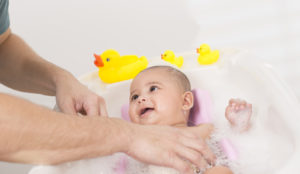Can an Infant Drown During Bath Time? — ‘In a Matter of Seconds’

Father bathing his adorable baby
Bath Safety Month takes place every January. The National Drowning Prevention Alliance’s annual outreach effort raises public awareness of the nearly 90 children who perish in the tub every year.
Sadly, the primary reason for those deaths is lack of supervision.
“Children can drown in only a few inches of water, so never leave a young child alone in the bath, even for a moment,” according to a blog on the alliance’s Web site. “If you can’t ignore the doorbell or the phone, wrap your child in a towel and take him along when you go to answer them.”
Even though Bath Safety Month has passed, it does not mean parents should forgo being vigilant in what experts describe as the most dangerous room in the house.
“Bathing is a part of our daily routine,” according to the blog. “It’s not uncommon for us to forget to take proper precautions while we or our children are in the bathroom. Remember a drowning can occur in as little as two inches of water. These incidents can be prevented if you implement layers of protection at home.”
Here are some facts:
- Most fatalities in the tub occur in children ages four and younger.
- Of those children, two-year-olds are most at risk.
- Toddlers still are growing and developing their strength, so when they fall or slip in the water, they land on their faces and heads.
“NEVER leave a baby alone, or with young siblings, in a bathtub even for a second,” the Consumer Product Safety Commission warns in an alert. “Always keep baby within arm’s reach. Children can drown quickly and silently. Keep the toilet lid down, and keep young children out of the bathroom when unsupervised. Consider placing a latch on the bathroom door out of reach of young children.”
Toilets often are overlooked as a drowning hazard, but statistics show the most common incidents involve children accidentally plunging headfirst into the porcelain bowl.
“Toilets may seem innocent, but they pose serious safety risks to little ones,” states an In the Know article titled “BATHROOM DANGERS AND HOW PARENTS CAN SPOT THEM: ‘YOUNG CHILDREN ARE PARTICULARLY AT RISK.’” “In addition to being a drowning hazard, toilets are full of harmful bacteria that little ones shouldn’t come in contact with. Therefore, always keep the toilet lid down and latched with a childproof safety lock.”
Andy Woods, owner of the British Swim School of Northeast Florida, said all it takes is a sudden lapse in judgement during the daily routine of bathing one’s child to lead to an untimely tragedy.
“A drowning can happen in a matter of seconds,” Woods said in a WJXT-TV story titled “Bathtub Safety Month: How to prevent child drownings at bath time.” “So, if you think about that, that’s you dropping your head to look for something. For example, if you don’t have the items you need for a child preparing for the bath such as towels or clothes or something to put on your child after you pull them out of the water. You know if you leave that bathroom to retrieve those items, it can happen that quick. It really comes down to the focus and attention is really the main things and one of the biggest struggles we have as adults.”
The Mayo Clinic advises parents to bathe infants two to three times per week instead of every day, lessening the risk.
“If you’re quick and thorough with diaper changes and burp cloths, you’re already cleaning the parts that need attention – the face, neck and diaper area,” it states in “Baby bath basics: A parent’s guide.” “Between baths, you may also check the folds of your baby’s skin, including thighs, groin, armpits and chin. If needed, clean these areas with a wet washcloth.”
The Mayo Clinic also advises parents to bathe infants in no more than two inches of water using a plastic tub or the sink.
“Line the tub or sink with a clean towel,” it states in the guide. “Gather the supplies you’d use for a sponge bath, a cup of rinsing water and baby shampoo, if needed, ahead of time. This will allow you to keep one hand on the baby at all times. A secure hold will help your baby feel comfortable – and stay safe in the tub. Use your nondominant arm to support your baby’s head and neck and the other to hold and guide your baby’s body into the water, feet first. Continue supporting your baby’s head and back as needed. You might reach behind your baby and hold on to his or her opposite arm throughout the bath.”
Share This


